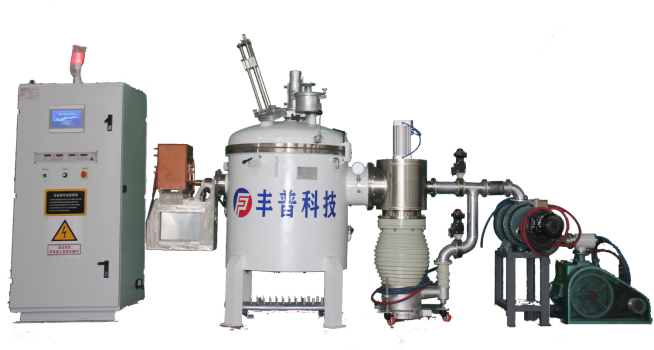A vacuum melting furnace is a high-end metallurgical device used for melting metals or alloys in a vacuum environment. It creates a vacuum inside the furnace, which has lower pressure than atmospheric pressure. This vacuum environment effectively controls oxidation, volatilization, and contamination during the melting process. Therefore, it helps produce metals or alloys with higher purity. Vacuum melting furnaces are widely used in high-tech industries like aerospace, automotive, electronics, and medical devices. These industries rely on them for producing high-purity and high-performance materials.
1. Basic Principles of Vacuum Melting
The principle of vacuum melting is to remove air or other gases from the furnace. This creates a vacuum with a lower pressure than atmospheric pressure. This environment helps control reactions between metals and external gases. As a result, it prevents undesirable reactions like oxidation and nitridation. This ensures that the metal maintains its purity and performance.
In the vacuum environment, metals or alloys melt and cast at lower pressure. Impurities in the metals are more likely to evaporate or be removed. Additionally, oxidation reactions are less likely to occur. Consequently, this process effectively produces metals with higher purity.
2. Major Applications
Aerospace: Vacuum melting furnaces are used to produce high-performance alloys and superalloys. These materials are essential for aerospace engines, gas turbines, and other components exposed to high temperatures and pressures. Therefore, vacuum melting is crucial in aerospace manufacturing.
High-Purity Alloy Production: Vacuum melting is widely used to make high-purity metals and alloys, such as titanium alloys, nickel-based alloys, and aluminum alloys. These alloys have special mechanical properties and resistance to corrosion. As a result, they are commonly used in high-tech industries.
Semiconductor Industry: In semiconductor manufacturing, precise alloy melting is essential for product performance. Vacuum melting furnaces offer a clean, contamination-free environment. This improves the quality of electronic products by minimizing impurities.
Precision Molds and Tools: Vacuum melting is also used to produce high-hardness, high-wear-resistant tool steels. These steels are crucial for manufacturing precision tools and molds. Hence, vacuum melting plays an important role in this field.
Medical Devices: Vacuum melting furnaces are essential in the production of high-performance and biocompatible materials for medical devices. Materials such as titanium alloys and artificial bone materials are produced using this process.
3. Advantages of Vacuum Melting
High-Purity Metals: Vacuum melting efficiently removes impurities such as oxygen, nitrogen, sulfur, and metal oxides. It is ideal for producing high-purity materials. Specifically, metals like titanium and zirconium are prone to oxidation, but the vacuum environment prevents this. Consequently, the final product quality improves significantly.
Prevention of Oxidation: In conventional melting processes, metals tend to react with oxygen at high temperatures. This forms oxides that negatively affect the metal’s properties. However, vacuum melting removes oxygen, preventing oxidation from occurring.
Precision Alloy Control: Vacuum melting allows precise control over alloy composition. It prevents the introduction of impurities, which helps in producing high-performance metals and alloys with specific properties. As a result, these materials meet the demands of high-precision applications.
Efficient Removal of Harmful Elements: Under high temperatures and low pressure, volatile elements like hydrogen, carbon, sulfur, and oxygen evaporate more easily. This helps effectively remove harmful elements from the metal.
Suitable for High-Temperature Melting: Vacuum melting is particularly suitable for high-melting-point metals, such as titanium, tantalum, and tungsten. These metals are difficult to melt under normal atmospheric conditions. However, they can be successfully melted in a vacuum environment.

4. Challenges and Future Directions of Vacuum Melting Furnace
Equipment Costs and Maintenance: Vacuum melting equipment requires significant initial investment and regular maintenance. The high cost and maintenance complexity may prevent small and medium-sized businesses from adopting the technology.
High Technical Requirements: Vacuum melting requires operators to have specialized knowledge and experience. Only skilled operators can ensure the process runs smoothly and efficiently.
Expanding Application Range: With advancements in materials science, the applications of vacuum melting are growing. It is especially important for developing new materials and producing high-performance alloys. Therefore, the future prospects for this technology are promising.
Overall, vacuum melting is an efficient and precise metallurgical process. It produces high-purity, high-performance metals and alloys. These materials meet the demands of various high-end manufacturing fields. As technology advances, vacuum melting will become even more widespread in high-tech industries.

